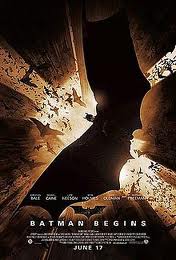
Watching the movies of the Dark Knight trilogy, it can be easy to come away feeling that the score, by Hans Zimmer and James Newton Howard, is composed of atmospheric music rather than catchy themes. But the motive for Batman is hard to miss as it consists of only two notes—D and F. Over the course of the film, these notes are used in three main ways: as an accompaniment figure, as a “signifying” form of the Bat-theme, and as a “heroic” form of the same theme. My film music analysis of these themes is below.
The Bat-Motive as Accompaniment
The first time we hear the D-F motive, it’s not actually a melodic “theme” but an accompaniment, a repeating figure (or “ostinato”) in the lower strings:

Although this accompaniment figure usually occurs with some form of the Bat-theme, it often fills out entire scenes with its dark agitated sound, as in the first scene in the film, which leads to the young Bruce Wayne falling down into a cave. You can hear this in the following excerpt from about 0:42.
In this light, the figure suggests that what we are shown onscreen is directly related to Batman’s origins or, at other times, that he is not far offscreen.
The Bat-Motive as “Signifying” Theme
When used as a theme, the D and F appear as single notes in a long crescendo, usually in the trombone and with the ostinato accompaniment:

The following clip has this theme at 0:52, 1:22 and 1:36.
If you’ve seen Batman Begins, this theme will sound familiar—we hear it more than any other theme in the film. While it is flexible in meaning, it seems to suggest that Batman is either being thought about by the character onscreen, or that there is great uncertainty in what Batman is trying to do. Depending on the context, then, the theme can be either positive or negative in connotation—it has no “default” meaning other than to simply signify Batman.
The Bat-Motive as “Heroic” Theme
This form of the theme is the most prominent in the film as it is sounded when Bruce or Batman performs a heroic feat. It has the same long crescendo and accompaniment as the “signifying” theme, but ends with a loud major chord scored for more brass than just the trombone:

The following clip has this theme starting from 2:23.
Throughout the film, the most prominent statements of the Bat-motives are always in the same key of D minor. But in this “heroic” form, the theme ends with a major chord (VI) in the minor key, giving the theme a positive feeling within a negative surrounding. This musical relationship mirrors that of Gotham City: Batman is the one glimmer of hope in a city filled with crime and corruption.
Putting it All Together
What is most interesting about all these forms of the Bat-motive is the way they progress towards heroic moments. In the first scene, when the young Bruce develops a fear of bats, we hear mainly the accompaniment figure. There are a couple of statements of the Bat-theme, but they are soft and in the strings, a hint of things yet to come. Then, events that push Bruce closer to the idea of becoming Batman are scored with the brassy “signifying” Bat-theme. These events include:
- Bruce walking up the mountain to the League of Shadows
- Bruce seeing the poverty of Gotham while in Rachel’s car
- Bruce running away from Falcone’s hangout (after switching coats with the homeless man)
- Bruce discussing the “symbol” (i.e., Batman) that will protect his loved ones while he fights crime
- Bruce re-entering the cave for the first time as an adult
Soon after Bruce’s re-entrance to the cave, a flurry of bats pours out and this time he allows them to pass over him, unafraid. For the first time in the film, we hear the “heroic” form of the Bat-theme, and for good reason. Bruce now has control over his fear of bats, and by extension, his fears more generally, and so is psychologically prepared to take on the persona of Batman. This scene, given in the last of the clips above, actually combines all three forms of the Bat-motive starting from 2:16.
I love this post, it explained alot! I was wondering whether you could tell me the musical concepts used in Batman Begins? I need it by next Wednesday for an Assignment. Thank you so much if you do. You can just send it to my email if you like 🙂
Also what are some musical concepts that James Newton Howard uses in one of the songs he has composed? I need to do a comparison with another artist, but I’m not sure if I have the right concepts. It can be for any famous song James has written. Thank you so much.
Thank you for posting this article, I’ve been searching high and low to find out what was different about the chord change motif. As in Batman begins, this is when the theme actually begins when he enters the cave. Just sounds so big. From D to F, So what seems to be a time you have helped me find out
Thank you very much